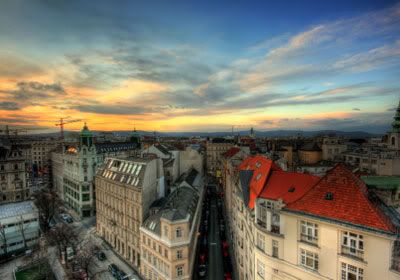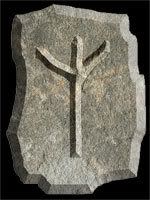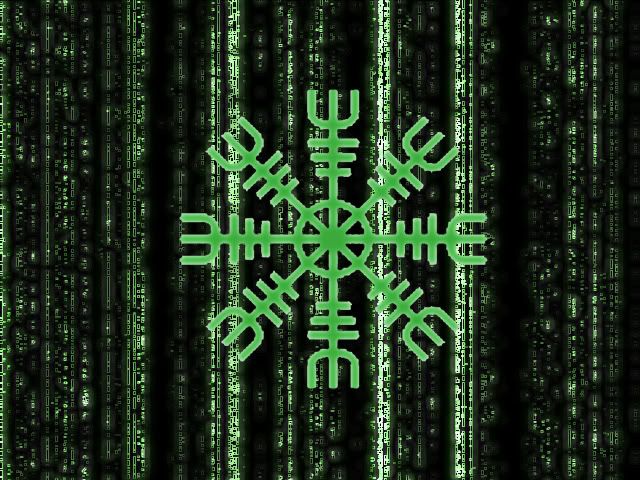 |
| Vienna, Austria: Birthplace of Guido von List |
The Algiz rune
"The Life Rune"
I decided that I had to add this Listian rune because there are some definite ancient Camun ties to it. Although the runes have an ancient Cisalpine origin, this particular rune is genuinely ancient Norse in origin. One question, which I have developed over this period of time, is whether or not List's runes were actually found on lower Austrian artifacts or present in any ruins there?
I had a funny synchronistic experience today. It happened as I drove my mother to an errand. I was reading the book in the car while she was inside shopping. When she returned to the car, I was energized having just read about the Algiz rune; and in particular, of one of it's alternate names "mon." The Camunian town and comune of Monno was originally named "Mòn" in the Camunian dialect. As we drove off, she said something like "I'm going to use these "Vienna sausages" for something I'm going to make for dinner tonight." Vienna? {{BINGO}} Vienna is the birthplace of Guido von List! A classic synchronistic connection. She doesn't even know who Guido von List is.
People and animals unwittingly play out this symbolism for others. Two weeks ago today, I brought up a subject out of the blue; and one of the people who was present was startled. "Oh, it's amazing that you brought that up!" he exclaimed, and he went onto a tangent about something which was important to him. That, however, is probably more of a mild psychic connection than a synchronistic one. About a week ago, while hiking, I was thinking about some of these subjects and I saw three ravens fly by. These ravens were playing out a synchronistic symbol for me. It wasn't synchronistic for them. Just me. That seems to be how it works. A living symbol is just going about its own journey; and any symbolic meaning is an entirely separate concept. "Three ravens," or any three birds, is a very ancient symbol in European paganism. It's present in one of the crests of a family of which I descend as well. List offers a mixed scientific-mystical explanation to this. It's a natural condition of this planet, although it has no hard science to back it up.
**************************************************
Algiz represents protection according to tradition. On another level, it represents divine inspiration and aspirations. What do the two have in common? The Valkryies are that common element. Valkryries were the warrioress, amazon-like daughters of Odin. They were the choosers of the dead on battlefields and lead the dead to the afterlife. They protected the souls of those who died, as well as those who were meant to remain alive. The tie to divine aspirations come from the fact that in some Germanic customs, it was believed that a Valkryrie was actually part of a persons higher consciousness, the "god-like" part of our own being. These all being the case, Algiz represents both protection and the divine consciousness withing each of us.
**************************************************
The Algiz is part of the ancient Nordic and Anglo-Saxon runic
alphabet, often equated to the modern day z, however was traditionally
pronounced yr. The letter has come to symbolize many neo-pagan religions
and is often worn as a pendant. When casting rune stones it is most
commonly determined to represent refusal to move on, or one's family and
heritage.
*Algiz, sometimes
*Elhaz, is the
reconstructed Proto-Germanic name for the
ᛉ rune, representing the
Proto-Germanic terminal
-z (from
PIE word-final
*-s). The reconstructed word
*algiz (meaning "
elk") is based on the name of the
Anglo-Saxon eolh
("elk") which is of the same shape but represented a different sound.
Like much of the Proto-Germanic language, it is not attested in any
known text.
Like the
Ing-rune,
*Algiz differs from the other runes because it was not named
acrophonically, since the sound it represents is a suffix. The
Proto-Germanic terminal
z (continuing
Proto-Indo-European terminal
s) became obsolete, and the rune is usually transcribed as
ʀ for
Proto-Norse and
Old Norse. The sound eventually became the terminal
-r in
Old Norse, but its continuation in the
yr-rune (see below) shows that there was still a phonemic difference between -
r and -
ʀ in Old East Norse (the Swedish and Danish dialect of Old Norse) in the 11th century.
Elder Futhark
In the
Elder Futhark, the reconstructed name
*Algiz
is given to the rune. *Algiz represents the sound of the letter "Z" in
the Elder Futhark. In the 8th century, the Elder Futhark began to be
replaced by the Younger Futhark in Scandinavia.
Gothic Futhark
In the
Gothic alphabet, the Gothic letter

, called
Ezec,
is identified with the rune. Like the Elder Futhark, the sound value of
the term was that of "Z" but the name of the rune is of uncertain
meaning.
[1]
Anglo-Saxon futhorc
Recorded in the
Anglo-Saxon rune poem, the shape of the rune appears in the
Anglo-Saxon futhorc alphabet, as
ᛉ Eolh.
However, instead of representing the sounds of the letter "Z" as in the
Elder Futhark and Gothic Futhark, it here represents the sound of the
letter "X".
[1]
Anglo-Saxon Rune Poem Modern English translation[2]
Eolh-secg eard hæfþ oftust on fenne The Elk-sedge usually lives in the fen,
wexeð on wature, wundaþ grimme growing in the water. It wounds severely,
blode breneð beorna gehwylcne staining with blood any man
ðe him ænigne onfeng gedeþ. who makes a grab at it.
 |
| The varying forms of the rune in the Elder futhark during the centuries |
Younger Futhark
As the
Younger Futhark gradually began to replace the Elder Futhark, the shape of the *Algiz rune appears again as
Yr ᛦ "
yew". The shape is also continued in another character in the Younger Futhark;
Maðr ᛘ ("
man"), replacing the Elder Futhark
ᛗ rune
*Mannaz.
Modern usage
Guido von List and influence
The
Madr and
Yr runes in
Guido von List's
Armanen Futharkh were very loosely based on the Younger Futhark. List's runes were later adopted and modified by
Karl Maria Wiligut who was responsible for their adoptions by the
NSDAP and subsequently used widely on insignia and literature during the
Third Reich, notably in SS-obituaries.
Germanic Neopaganism
Various forms of the *Algiz rune are commonly used by various
Germanic Neopagan groups as a symbol of their religion.
See also
Notes
- ^ a b Dobbie (1942).
- ^ Page (1999:71).
- ^
From the official National Alliance website: "The Life Rune signifies
life, creation, birth, rebirth, and renewal. It expresses in a single
symbol the raison d’etre of the National Alliance and of the movement of Aryan renewal." The symbol is used throughout the website. "The Life Rune: an ancient symbol used by the National Alliance". Natall.com.
References
**************************************************
 Guido von List's "Algiz rune" (he used different names):
Guido von List's "Algiz rune" (he used different names):
man, mon, moon (ma = to mother, to increase; empty or dead).
A fifteenth I tell, which Folk-rast the dwarf
sang before the Doors of Day
to the Ases [Aesir] for strength, to the Elves for might,
to myself to clear my mind
In another sense, as in that of the well-known folktale, "the Man in the Moon" reveals himself in the fifteenth rune as a sanctified sign of the propagation of the human race. The primal word "ma" is the hallmark of feminine generation--"mothering"--just as the primal word "fa" is that of the masculine. Therefore, we have here "ma-ter" (mother) just as there we have "fa-ter" (father). The moon mythico-mystically serves as the magical ring Draupnir (Dripper), from which every ninth night an equally heavy ring drips (separates itself), and which was burned with Baldr; that is, Nanna, the mother of his children, was burned at the same time as Baldr.
According to mythico-mystical rules, however, nights always mean months, and so the "nine nights" mentioned above indicate the time of pregnancy. While the concepts of man, maiden, mother, husband, [Gemahl], wife [Gemählin], marriage, menstruation, etc., etc. are rooted in the primal word "ma" (just like the concept "moon," with which they are all internally connected conceptually), they nevertheless symbolize individual concepts reconnected into an apparent unity according to the principle of the multiune-multifidic multiplicity.
So too is the conceptual word for this unity rooted in the primal word "ma" and expressed "man-ask" or "men-isk," that is: man [Mensch]. Therefore--as a concept of unification--the word "man" is only of one gender (masculine), while the derogatory concept belongs to the third stage as a neuter, to which we will return later. The fifteenth rune encompasses both the exoteric and the esoteric concept of the high mystery of humanity and reaches its zenith in the warning: "Be a man!"
**************************************************

Again, the old name for the town and comune of Monno is "Mòn." Therefore, there is a definite tie-in here. Linguistically, if nothing else. As to whether that origin is Euganeian (ancient Alpine), Gaulish, or Germanic; we just don't know. On the
Moon Wikipedia webpage, under "Name and etymology," it states the following:
The English
proper name for Earth's natural satellite is "the Moon".
[7][8] The noun
moon derives from
moone (around 1380), which developed from
mone (1135), which derives from
Old English mōna (dating from before 725), which, like all
Germanic language cognates, ultimately stems from
Proto-Germanic *mǣnōn.
[9]
The principal modern English adjective pertaining to the Moon is
lunar, derived from the Latin
Luna. Another less common adjective is
selenic, derived from the Ancient Greek
Selene (
Σελήνη), from which the prefix "seleno-" (as in
selenography) is derived.
[10]
- N/A
- NA
- N/A
- N/A
- N/A
- N/A
- ^ "Naming Astronomical Objects: Spelling of Names". International Astronomical Union. Retrieved 29 March 2010.
- ^ "Gazetteer of Planetary Nomenclature: Planetary Nomenclature FAQ". USGS Astrogeology Research Program. Retrieved 29 March 2010.
- ^ Barnhart, Robert K. (1995). The Barnhart Concise Dictionary of Etymology. USA: Harper Collins. p. 487. ISBN 0-06-270084-7.
- ^ "Oxford English Dictionary: lunar, a. and n.". Oxford English Dictionary: Second Edition 1989. Oxford University Press. Retrieved 23 March 2010.
Middle English mone, from Old English mōna; akin to Old High German māno moon, Latin mensis month, Greek mēn month, mēnē moon
First Known Use: before 12th century
I'm not sure if it's a certainty that the most basic root word(s) for moon has a Germanic origin, since it was present in Latin and Greek. The 12th century period is for "moon," but other words starting with an "m" may go back deep into the ancient world.
According to
20000-Names.com, "Monday" is an English name derived from the week day name, composed of the Old English elements mona "moon" and dæg "day," hence "moon day."
According to
the book 'Creed of Iron' (McVan; 1997): The name "moon" means "the measurer" or one who metes out time with her
phases and movements. The word "mon-th" in its origin means "a
measurement of the moon."
**************************************************
According to 'Creed of Iron', the Algiz run is described as the following:
ELHAZ - elk
(z) Life, protection, connection between gods and men.
* Black tourmaline
Also known as algiz, it is symbolic of a spread hand or an elk's antlers, both being signs of active defense. A rune of protection and of purifying, it is associated with a swan or valkyrie and with striving towards one's potential. Elhaz is the life symbol and was often carved into spears for protection and victory.
[Also, it symbolizes the top
chakra: The crown of the head, governing consciousness and higher self.]
**************************************************
One more time
Just as I was finishing this post, just a few minutes ago, my mother called. After a brief discussion about her plans for Sunday, she said something like "have you seen the moon tonight? It's so bright!" {{BINGO}} In addition to the connection to the moon (List: "mon"), the Algiz rune stands for "mother" (List: "ma") The moon administers time for the earth, like "mothering"; as she just administered time for me as to what time to pick her up tomorrow and to remind me to turn back my clock one hour for daylight savings. She was definitely my synchronistic connection for the day.
.









